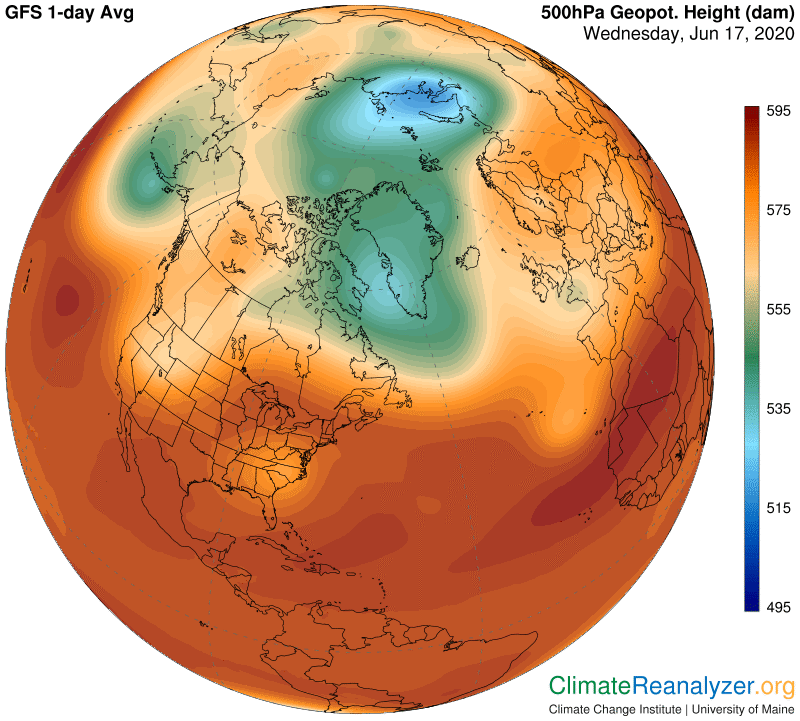The temperature feedback loop I have been defining, which is now having such a powerful effect on the entire Arctic region, does not actually have any limitations with respect to geography, strength or direction. The Arctic is just a worst case. The same basic principles are applicable to every one of the individual regions found in the Weather Map base. As confirmation, I will next give you some ideas about how to do an investigation that should work on any or all of them. North America is always a good choice because it normally has so many interesting things going on, especially now in the high north. The best place to start is with the 500hPa image, the one so full of unexpected changes in these times. Notice how much it has changed again since yesterday, just as it did the day before, at an extraordinarily fast rate indicating an extreme and possibly dangerous degree of acceleration of the revolving feedbacks.

This is the image that tells us exactly where the three main jetstream pathways will be located, according to the rules explained several times in recent letters. You can investigate whether or not this mode of positioning will always holds true, not just on this map today, but on any of the other regional maps on any day when you are ready to act. The 500hPa map can also provide some advance clues about how strong the various high-speed jets will be, by how the pathways are arranged. You’ll need to toggle back and forth a number of times between the two map images in order to gain confidence in these relationships. The underlying theory in this situation holds that the complete 500hPa configuration (the same being true at any altitude, not just the 500 one) establishes exactly where the jetstream pathways will be located and their potential wind strength.
Next we want to investigate the relationship between jetstream pathways, especially when the jet winds are strongest, and the movement of any precipitable water streams that happen to be in the same area. The theory holds that the jets, when present, will have a strong influence on the water streams’ movements, which is always generally poleward and usually with an easterly bias as well. Strong jets either steer the movement or block it completely. The weaker the jets are the more opportunity there is for water streams to move as they want and for their vaporous gases to diffuse. Again, confirmation comes by means of toggling many times between the two map images to compare how details evolve.
Next, we want to check out the relationship between visible bodies of high-altitude precipitable water streams and their diffused vapors, wherever they may be seen to exist, and contemporary air temperatures at the planetary surfaces directly below them. Theory holds that there is a powerful—but certainly not uncomplicated—greenhouse effect that can raise the temperature by some number of degrees above normal. You can see if this is generally true by toggling back and forth between the precipitable water images and those of air temperature anomalies, giving extra attention to continental land regions. (A third map may be needed to check for heavy cloud cover.) Many strong examples should normally be visible.
Finally, we want to see whether the significantly large and strong warm anomalies that actually occur are having a noticeable effect on the structure of the 500hPa map. Theory holds that when air warms its gases will forcibly expand in all directions, including upward, and this force will often be great enough to cause meaningful changes in the 500hPa structure. Moreover, the changes due to warming will tend to weaken the ability of jetstream pathways within the structure to produce strong jets. This last point cannot be verified in one day, instead requiring a large number of observations of widely differing 500hPa structures and noticing what kind of jets they are able to produce. Cold anomalies, when they occur, should normally be found to have exactly the opposite effect on 500hPa structures as warm ones, reversing the entire direction of the feedback loop if and when they gain a regional monopoly—not something we need to worry about these days.
Carl





















